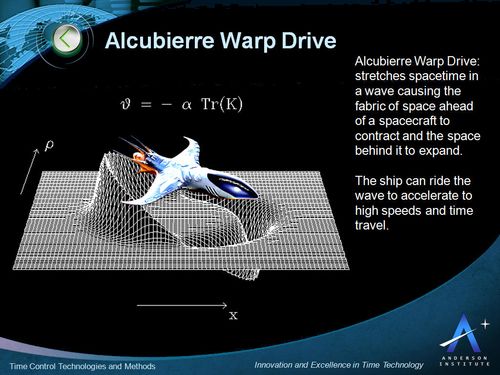

| Visitors Now: | |
| Total Visits: | |
| Total Stories: |

| Story Views | |
| Now: | |
| Last Hour: | |
| Last 24 Hours: | |
| Total: | |
NASA Scientists Engineering a Warp-Drive Solution for Faster-Than-Light Space Travel
Tuesday, July 23, 2013 17:05
% of readers think this story is Fact. Add your two cents.
July 23, 2013 – According to state-of-the art theory, a warp drive could cut the travel time between stars from tens of thousands of years to weeks or months.
Harold G. White, a physicist and advanced propulsion engineer at NASA and other NASA engineers are trying to determine whether faster-than-light travel — warp drive — might someday be possible.
Watch the video: NASA Warp Drive Project – “Speeds” that could take a spacecraft to Alpha Centauri in a mere two weeks — even though the system is 4.3 light-years away

Image credit: With thanks to http://www.patrickshrier.com/tag/alcubierre-drive/
The team has attempting to slightly warp the trajectory of a photon, changing the distance it travels in a certain area, and then observing the change with a device called an interferometer.
“Space has been expanding since the Big Bang 13.7 billion years ago,” said Dr. White, 43, who runs the research project told the
“And we know that when you look at some of the cosmology models, there were early periods of the universe where there was explosive inflation, where two points would’ve went receding away from each other at very rapid speeds.

Nature can do it,” he added. “So the question is, can we do it?”
In 1994, a Mexican physicist, Miguel Alcubierre, theorized that faster-than-light speeds were possible in a way that did not contradict Einstein by harnessing the expansion and contraction of space itself.

Image credit: With thanks to http://www.patrickshrier.com/tag/alcubierre-drive/
Under Dr. Alcubierre’s hypothesis, a ship still couldn’t exceed light speed in a local region of space.
But a theoretical propulsion system he sketched out manipulated space-time by generating a so-called “warp bubble” that would expand space on one side of a spacecraft and contract it on another.
The Daily Galaxy via New York Times and Dr. David Lewis Anderson/Anderson Institute
The Daily Galaxy
Read more here:
More info: Results of his Alcubierre Drive rethink:
The warp drive: hyper-fast travel within general relativity:


